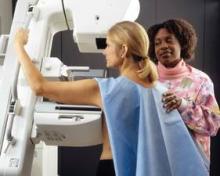The probability that a breast cancer patient’s life was saved by mammography screening is always less than 25%, according to various "plausible estimates" of the risk of developing and dying from breast cancer published online Oct. 24 in the Archives of Internal Medicine.
In fact, given that the most recent data "confirm that the current benefit of screening mammography is disappointingly small," the probability that a typical woman whose breast cancer was detected by screening mammography owes her life to that procedure "is now likely to be well below 10%," said Dr. H. Gilbert Welch and Ms. Brittney A. Frankel of the Dartmouth Institute for Health Policy and Clinical Practice, Hanover, N.H.
More people are likely to personally know a cancer survivor than ever before, as the proportion of survivors in the general U.S. population has more than doubled in recent years and now stands at 4%. "Breast cancer survivors are particularly common: they now represent approximately 2.5 million, or one-fifth of the current survivor population."
And "survivor stories" feed the public’s presumption that every survivor whose cancer was detected by mammography has had her life saved by that screening. Most people don’t realize that in many cases, the cancer would have been equally treatable if it hadn’t been detected until it presented clinically. And in many other cases, the malignancy was "overdiagnosed" – it would never have caused symptoms or death if it had been left undetected and untreated.
"It is important to acknowledge that these alternatives exist," they wrote.
They calculated the probabilities that a screening mammography saved a patient’s life using the National Cancer Institute’s DevCan 6.5.0, a tool that helps compute the risks of developing and of dying from cancer at specific ages, based on detailed national epidemiologic data. "The risk of having screen-detected cancer was estimated simply as the product of the risk of developing breast cancer and the proportion of breast cancers found by mammography," they said.
"The absolute risk reduction in mortality due to mammography, or mortality benefit, was calculated as the difference between the estimated 20-year risk of death without mammography and the 20-year risk of death observed currently. The probability that a woman with screen-detected breast cancer has avoided breast cancer death because of screening was the ratio of the mortality benefit and the probability of having screen-detected breast cancer," they noted.
Their results show the estimated relative risk reduction in breast cancer mortality at ages 40, 50, 60, and 70 years, under a variety of conditions.
For example, assuming that screening mammography reduces the risk of breast cancer death by 20% for a 50-year-old woman, the probability that such a 50-year-old woman with a mammography-detected breast cancer has avoided a death from breast cancer is 13%.
The probability that a typical woman whose breast cancer was detected by screening mammography owes her life to that procedure "is now likely to be well below 10%."
If one of the underlying assumptions is changed – for example, assuming that screening mammography reduces the risk of breast cancer by 25% rather than 20% – this probability rises to 17%. If one assumes that screening mammography instead reduces the risk of breast cancer by only 5%, this probability falls to 3%.
The researchers discovered that "the most dramatic" effect of screening mammography on survival occurs in the 70-year-old age group, "because the proportion of screen-detected cancers in this age group is relatively low (52%)." Nevertheless, even in this group the probability that screening mammography saves a woman from breast cancer death remained under 25%.
"All analyses yielded probability estimates below 25%," Dr. Welch and Ms. Frankel noted (Arch. Intern. Med. 2011 Oct. 24 [doi:10.1001/archinternmed.2011.476]).
The benefit of screening mammography has declined over time, in part because women present earlier when they find a breast lump on their own and in part because treatment of such cancers has improved. "Consequently, we believe that readers should focus on the values toward the low end (5%-10%) and recognize that the probability that a woman with screen-detected breast cancer has, in fact, avoided a breast cancer death because of screening mammography is now likely to be well below 10%," they added.
It is important to use this information "to put cancer survivor stories in their proper context," the investigators said.
No financial conflicts of interest were reported.


